Stories
Welcome to the Stories section of RobertMusso.com. Here you will find some personal memories of various albums I have worked on, chance encounters, and what some of my peers are up to these days
Rest in Peace - Unfortunately, there are more than several musicians that I have had the honor to play or work with that are no longer with us. They include, my good friends Lance Carter and Thomas Chapin, Master musicians Sonny Sharrock, Derek Bailey, Tony Williams and my teacher Ted Dunbar, and also friends Phillip Wilson and Felix Pappalardi. God Bless you all.
Musicians
Miles Davis | Bill Laswell | John Zorn | James Brown | Ornette Coleman | Stevie Wonder | John "Lunar" Richey |
Jair-Rohm Parker Wells | Lance Carter | Bil Bryant | Thomas Chapin | Sonny Sharrock | Bootsy Collins | Bernie Worrell
Sessions
North Africa with Pharaoh Sanders | Recording in Australia | The Transonic albums | Ataxia |
Transonic Re-Evolution | PIL Album
Recording
Orange Music Sound Studios | Greenpoint Studio | The Quality of Live Recordings | Current Studio Philosophies |
Home Recording vs. Studio Recording | The Professional Recording | Troubleshooting and Problem Solving |
How important it is to be a good musician...
My Bands
The Beginnings of Machine Gun | The Complete Machine Gun | Machine Gun - The Radio Tour |
Machine Gun - The Guests | Some Machine Gun Shows | Bil Bryant and Jair-Rohm Parker Wells | Bob's Jam Band
Everything Else
MuWorks Records | MuWorks Meetings | The MuWorks Crew | Downtown Music Gallery
MuWorks Original Catalog
1) Machine Gun – Machine Gun 1988 CD, LP, Cass. -
MU 1001
2) Robert Musso – Absolute Music 1989 CD, Cass. -
MU 1002
3) Machine Gun – Open Fire 1989 CD, LP, Cass. -
MU NY 1003
4) Pheeroan akLaff – Sonogram 1989 CD -
MUW 1004
5) Thomas Chapin – Radius 1990 CD -
MUW 1005
6) Lunar Bear Ensemble – Dark Pastures 1991 CD, LP -
MUW 1006
7) Improvised Music NY 1981 1992 CD -
MUW 1007
8) Robert Musso – Active Resonance 1992 CD, Cass. -
MUW 1008
9) Thomas Chapin & Borah Bergman – Inversions 1992 CD -
MUW 1009
10) John McCracken & Outloud – Blood from a Tone 1992 CD -
MUW 1010
11) Machine Gun – Pass the Ammo 1992 CD, Cass. -
MUW 1011
12) Last Exit – Headfirst Into the Flames 1993 CD -
MUW 1013
13) Electric World – Life = Love 1993 CD -
MUW 1014
14) State of the Union – Various Artists 1993 CD -
MUW 1016
15) Lunar Ensemble – Offbeat 2007 CD -
MUW 1017
Musicians
Miles Davis - Miles Davis is mentioned three times in my discography/ sessionography. The first was before his comeback. There was talk with his management and record company about working with him and I remember, we spent two or three days in the studio constructing a "rockit-ish" type of track for Miles to play on. Unfortunately Miles never did play on the track, and I have no idea what happened to the original tape. The second mention of Miles Davis is the Panthalassa record that Bill and I did. This was a great record to work on, one of my favorites, because we were using tape copies of the original multi track tape recordings from the On the Corner and In a Silent Way records, and it was really interesting to see how those original records were put together and how they were recorded. Miles usually had two tracks on the multi-track tape. The first was the clean microphone in front of his trumpet; the second track was the trumpet through a wah-wah pedal into a guitar amplifier. A microphone placed in front of the guitar amp was then recorded to the second track. The two were blended together during the mix.
I think it was 1987. I was sent to Paris to find a studio to record a few records and I remember, after visiting 12 studios over a two day period, I choose studio Plus Tronte, and we ended up recording Manu Dibango’s "Electric Africa" CD and the Toure Kunda’s "Natalya" CD there.
One day at the beginning of a session at the studio Miles Davis walks in with his entourage. He was wearing a black leather hat, a black-tie, a black shirt, a black jacket, a black leather cape, black leather pants and black boots, and he walked in the studio and came up to me while I was sitting behind the console, (which was a new SSL 4000 series console.) and Miles starts asking me questions about the console, and the studio and the main speaker monitors, and also the Fairlight synthesizer that Bernie Worrell (from Parliament/ Funkadelic) was playing while we were getting ready to start the session. We spoke for about 15 or 20 minutes, Miles asking questions and me answering. The whole time, Bernie Worrell was playing the keyboard and the assistant was hooking up the direct boxes and getting the two inch multi track tape on the machine. While Miles and I were talking Bernie came up with an incredible riff. Unfortunately when everything was finally hooked up and the tape was on the tape machine, cued up, ready to record, Bernie Worrell couldn't remember the riff that he was playing the whole time I was talking to Miles. Miles saw this, and then came up to Bernie and said, "I Got It Right Here" and pulled a little tape recorder out of his shirt pocket! He had been recording our entire conversation, including Bernie’s riff! So, in the end I actually never recorded Miles Davis. He, however did record me.
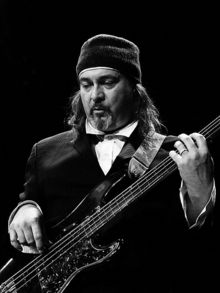 Bill Laswell - I met Bill Laswell, on Labor Day 1982 at RPM studios on 12th street in New York City. I was subbing for another engineer and the session was for Material, which was then Bill Laswell and Michael Beinhorn. We were recording a singer and a saxophone player and then mixing the song afterward. As it turned out the singer was Whitney Houston, and it was the first time she was ever being recorded in the studio, and I remember she didn't really feel comfortable wearing headphones while she was singing. (She had only been singing in church before then). The sax player was Archie Shepp! I remember when we recorded Archie. I was talking about doing fly-ins. That is taking a solo or a vocal from one part of a song and moving it to another part by recording the track from the multi-track tape to a ½ inch tape machine, and then "Flying" the ½ inch tape back to the multi-track tape – but at a different spot on the multi-track tape. I ended up doing that to a solo that Archie Shepp took on the song "Memories" on the Material record "One Down". This was the first session I worked with Bill on. We hit it off right away because of our similar sense of humor. That day Bill was wearing white painter’s pants, untied high top sneakers, and a Yankees cap on backwards.
Bill Laswell - I met Bill Laswell, on Labor Day 1982 at RPM studios on 12th street in New York City. I was subbing for another engineer and the session was for Material, which was then Bill Laswell and Michael Beinhorn. We were recording a singer and a saxophone player and then mixing the song afterward. As it turned out the singer was Whitney Houston, and it was the first time she was ever being recorded in the studio, and I remember she didn't really feel comfortable wearing headphones while she was singing. (She had only been singing in church before then). The sax player was Archie Shepp! I remember when we recorded Archie. I was talking about doing fly-ins. That is taking a solo or a vocal from one part of a song and moving it to another part by recording the track from the multi-track tape to a ½ inch tape machine, and then "Flying" the ½ inch tape back to the multi-track tape – but at a different spot on the multi-track tape. I ended up doing that to a solo that Archie Shepp took on the song "Memories" on the Material record "One Down". This was the first session I worked with Bill on. We hit it off right away because of our similar sense of humor. That day Bill was wearing white painter’s pants, untied high top sneakers, and a Yankees cap on backwards.
Bill Laswell Plays on: Robert Musso – Absolute Music, Robert Musso – Active Resonance, Robert Musso – InnerMedium, Transonic 1 (Downstream Illusion), Transonic 3 (Future Primitive), Last Exit – Headfirst Into the Flames, Improvised Music New York 1981, Transonic – Re-Evolution, and Musso, Laswell, Carter 11/7/04.
--------------------------------------------------------------------------------------------------------------------------------------------------
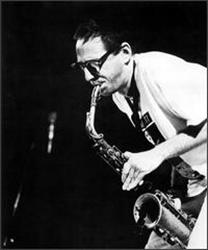 John Zorn – I think I was first introduced to John Zorn before one of his gigs around 1980 - 1981. Thomas Chapin told me about this wild saxophone player that I should check out. So we went to see him play in New York when we were both still living in the New Brunswick, New Jersey area. I remember, for part of the gig, he was just playing mouthpieces or maybe bird calls, and it was definitely wild.
John Zorn – I think I was first introduced to John Zorn before one of his gigs around 1980 - 1981. Thomas Chapin told me about this wild saxophone player that I should check out. So we went to see him play in New York when we were both still living in the New Brunswick, New Jersey area. I remember, for part of the gig, he was just playing mouthpieces or maybe bird calls, and it was definitely wild.
A few years later John hired me to mix his tribute record to Ennio Morricone, "The Big Gun Down". I really respect everything that John has done since then. He's one of the true visionaries of the New York music scene. I always try to help him, when I can. I was even able to get him a great deal on the PA system for the Stone.
-------------------------------------------------------------------------------------------------------------------------------------------------
Stevie Wonder - While I was working at the Hit Factory in 1981-82. Stevie Wonder came to the studio unexpectedly and wanted to record. (At 2:30 in the morning). His engineer Gary O. had missed his plane flight and wasn't there, and so I got to work with Stevie Wonder that day. He sat down at the console next me and I asked him if he was familiar with the new MCI 636 console and he turned to me and said, "Oh yeah. I've seen them before!"
After that, we proceeded to record some background vocals, and some percussion, and then at the end of the session, one of his roadies unpacked a new Sony stereo digital recorder. None of us had seen one before. And I remember, Dave Smith, who was in charge of studio maintenance, coming into the control room asking if we could compare it to our Studer half-inch tape machine. So I set up a few microphones on the piano (Neumann M49’s) and a vocal mic for Stevie (Sony C - 800) and then recorded him on both machines. The funny thing is, he started singing his song. "You and I", and when he came to the bridge, Instead of singing the normal lyrics he sang, "Oh you broke my heart, you made me break your jaw" etc. It was really hysterical. The digital recording, sounded a little brittle on the top end, but had no hiss, where the half-inch tape machine sounded warm and full, but did have the tape hiss. I believe that Dave Smith (God rest his soul) took home the half-inch recording.
--------------------------------------------------------------------------------------------------------------------------------------------------
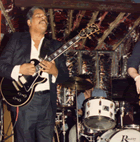 Sonny Sharrock - Sonny Sharrock was the best. He was just a great guy to be around. I enjoyed listening to him play with Last Exit. I enjoyed recording him and his band and I enjoyed playing with him when he sat in with Machine Gun. He was always a blast to be with, and what an incredible guitar player. He would play solos I just couldn’t believe. He could also be really funny. Once before a gig he was doing with Last Exit in Japan, I met him in his hotel room where I found he was playing scales up and down the guitar neck – but on this really bad guitar with very high string action and very heavy strings. I asked him why he was practicing on such a ratty guitar when his Gibson Les Paul guitar was also in the room. He said, "Hey I practice on the old thing so that I can burn when I play the Les Paul." It was always a treat just to be able to hang out with Sonny. I learned a lot about the guitar from him and he became a great influence on me and my playing. Sometimes I wonder what he would be playing right now, if he was still around.
Sonny Sharrock - Sonny Sharrock was the best. He was just a great guy to be around. I enjoyed listening to him play with Last Exit. I enjoyed recording him and his band and I enjoyed playing with him when he sat in with Machine Gun. He was always a blast to be with, and what an incredible guitar player. He would play solos I just couldn’t believe. He could also be really funny. Once before a gig he was doing with Last Exit in Japan, I met him in his hotel room where I found he was playing scales up and down the guitar neck – but on this really bad guitar with very high string action and very heavy strings. I asked him why he was practicing on such a ratty guitar when his Gibson Les Paul guitar was also in the room. He said, "Hey I practice on the old thing so that I can burn when I play the Les Paul." It was always a treat just to be able to hang out with Sonny. I learned a lot about the guitar from him and he became a great influence on me and my playing. Sometimes I wonder what he would be playing right now, if he was still around.
Check out Sonnysharrock.com.
Sonny Sharrock plays on: Machine Gun – Machine Gun, Machine Gun - Open Fire, Last Exit – Headfirst into the Flames, Improvised Music New York 1981, Machine Gun live at CBGB’s #1, Machine Gun live at the Gas Station, and Pheeroan akLaff – Sonogram.
--------------------------------------------------------------------------------------------------------------------------------------------------
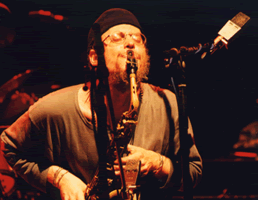 Thomas Chapin -
When I first got to Rutgers, and started hanging out at the jazz department and started playing with the jazz ensemble, I heard about Thomas Chapin. Then one day, about a month later. I was in one of the practice rooms behind the auditorium, when I heard this incredible saxophone playing. I mean this guy was just ripping - running through all the scales and all the arpeggios up and down, back and forth. I was really impressed and when he finally came out of the room I introduced myself and we eventually became friends. We would occasionally hang out and turn each other onto different types of music. At that time, I was studying with Ted Dunbar, and I remember turning Thomas onto the Smokin’ at the Half Note record by Wynton Kelly featuring Wes Montgomery. At that same time he was turning me on to Indian flute players and Irish folk songs. He used to wear a button on his shirt pocket back then that said, "I Read". We used to say he could read around the corner. That's how good he was. So when it came time to putting Machine Gun together, years later, he was the obvious choice. Before Machine Gun the only time that we had played together was in the jazz ensemble, which was with probably 30 or 40 other musicians. He was always the lead soloist, he was always the best. I still miss Thomas ‘Rage" Chapin. We had so many good times together. He was unbelievable. He had so much energy!
Check out Thomas Chapin.com
Thomas Chapin -
When I first got to Rutgers, and started hanging out at the jazz department and started playing with the jazz ensemble, I heard about Thomas Chapin. Then one day, about a month later. I was in one of the practice rooms behind the auditorium, when I heard this incredible saxophone playing. I mean this guy was just ripping - running through all the scales and all the arpeggios up and down, back and forth. I was really impressed and when he finally came out of the room I introduced myself and we eventually became friends. We would occasionally hang out and turn each other onto different types of music. At that time, I was studying with Ted Dunbar, and I remember turning Thomas onto the Smokin’ at the Half Note record by Wynton Kelly featuring Wes Montgomery. At that same time he was turning me on to Indian flute players and Irish folk songs. He used to wear a button on his shirt pocket back then that said, "I Read". We used to say he could read around the corner. That's how good he was. So when it came time to putting Machine Gun together, years later, he was the obvious choice. Before Machine Gun the only time that we had played together was in the jazz ensemble, which was with probably 30 or 40 other musicians. He was always the lead soloist, he was always the best. I still miss Thomas ‘Rage" Chapin. We had so many good times together. He was unbelievable. He had so much energy!
Check out Thomas Chapin.com
Thomas Chapin plays on all Machine Gun albums, Robert Musso – Active Resonance, Thomas Chapin – Radius, Thomas Chapin &Borah Bergman – Inversions, and John McCracken &Outloud – Blood From A Tone.
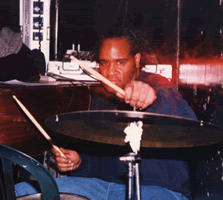 Lance Carter - I met Lance when he subbed for Bil Bryant at a Machine Gun gig. I could tell right away he was a great drummer, and I was going to love playing with him because he was such a strong driving musical force and he had such a powerful, big sound. Lance was one of the few drummers I've ever played with that could really sound like John Bonham, if he wanted to, he had that big of a sound. Lance later played in my Transonic band and on my InnerMedium CD, and we both played in a blues band for a while. We became really good friends, and started hanging out, jamming, checking out bands, and even went to a few Yankee games together. When he married my friend Lisa Cooney, it was truly one of the best of times. Lance was a funny guy and he loved to have a good time. Lance and I did one gig with Bill Laswell at the Bowery Poetry Project in the fall of 2004, and were planning on doing more - unfortunately this was the last show that I played with him. He was always a pleasure to be around and a truly great drummer, always a pleasure to play with. I’m still getting over his passing on November 1, 2006. There was a tribute concert for the organizations that helped Lance Carter at the Knitting Factory, NYC. I went on first at 7:00pm with some of my friends: John Richey, Elliott Levin, Dave Dreiwitz, Sim Cain, and Raoul Bjorkenheim. Cassandra Wilson, Marc Ribot, Elliot Sharp, Charles Burnham, Percy Jones, Eric Mingus, and the Harriet Tubman band also performed that evening.
Lance Carter - I met Lance when he subbed for Bil Bryant at a Machine Gun gig. I could tell right away he was a great drummer, and I was going to love playing with him because he was such a strong driving musical force and he had such a powerful, big sound. Lance was one of the few drummers I've ever played with that could really sound like John Bonham, if he wanted to, he had that big of a sound. Lance later played in my Transonic band and on my InnerMedium CD, and we both played in a blues band for a while. We became really good friends, and started hanging out, jamming, checking out bands, and even went to a few Yankee games together. When he married my friend Lisa Cooney, it was truly one of the best of times. Lance was a funny guy and he loved to have a good time. Lance and I did one gig with Bill Laswell at the Bowery Poetry Project in the fall of 2004, and were planning on doing more - unfortunately this was the last show that I played with him. He was always a pleasure to be around and a truly great drummer, always a pleasure to play with. I’m still getting over his passing on November 1, 2006. There was a tribute concert for the organizations that helped Lance Carter at the Knitting Factory, NYC. I went on first at 7:00pm with some of my friends: John Richey, Elliott Levin, Dave Dreiwitz, Sim Cain, and Raoul Bjorkenheim. Cassandra Wilson, Marc Ribot, Elliot Sharp, Charles Burnham, Percy Jones, Eric Mingus, and the Harriet Tubman band also performed that evening.
Check out Lance’s site at: lancecarter411.blogspot.com
--------------------------------------------------------------------------------------------------------------------------------------------------
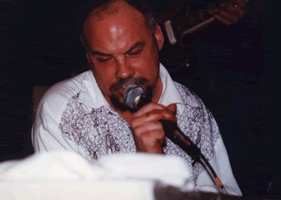
John "Lunar" Richey - John "Lunar" Richey is one of my oldest friends. He was the "Poet" and "Cut-Up/ Tape Manipulator" for Machine Gun. He plays on all of the Machine Gun albums. His Lunar Bear Ensemble and Lunar Ensemble albums include: Dark Pastures, OffBeat, Moon Lit Night, Acoustic at The Saint, Electric at The Saint, Acts of Love, Lucky Live, The Anima Within, and Poet Tree Absinthe.
He can be reached at: www.myspace.com/lunarensemble
--------------------------------------------------------------------------------------------------------------------------------------------------
Ornette Coleman - My friend Hassan Haiserman (Jarold "Bongo Jerry" Haiserman) introduced me to Ornette Coleman in the mid-1980s. At the time Ornette was living in an unused school on the corner of Rivington and Ridge Streets in New York City. I remember he had one room that was full of tapes of different recordings of his past bands. The tapes were in all different formats and just piled on top of each other. I offered to help transfer them, but nothing ever came of that. Never the less - I thought Ornette was simply incredible. His style, his sound, the way he puts together music - is uniquely beautiful. I got a chance to work on one of his records a few years later (Live at the Caravan of Dreams), and he asked me to do the live sound mixing for a few of his shows in the mid-west. I mentioned to him I was much better in the studio, rather than doing live sound. I commented to him that I liked the rewind button too much, but that didn't change his mind and I still did the live sound gigs.
Ornette would like to test me. He’d come to my sessions and I'd be right in the middle of recording a complex string section or something else very involved and he would ask me one of his harmolodic questions, "OK. If you have a C minor 7th chord and you put a G flat major chord on top of it what scales could you play?" My answer was usually, "Give me a second". And then I’d say a "G flat diminished could work". Then we would talk about that.
I would call him up every year and wish him happy birthday. One time in 2007 he asked if I’d like to come over and play with him at his place. I of course said yes thinking, who else would be there? When I showed up I realized it was just him and me! We played for about an hour and I recorded it. I hope to release that recording someday. I still miss Ornette very much.
Check out: Ornettecoleman.com
--------------------------------------------------------------------------------------------------------------------------------------------------
James Brown – My friend Joel Webber, who was an A&R man for Island Records, introduced me to James Brown at his hotel room during one of the New Music Seminar conferences in New York City in the early 1980’s. We went into his hotel room, and he was sitting underneath one of those professional, bee hive shaped, floor standing hair dryers, and he was getting a manicure. I really couldn't say anything after that, except I was a big fan of his.
Bootsy Collins -
A few years later, when I was working with Bootsy Collins, I asked him if the stories were true about James Brown fining members of his band for not having shined shoes. Bootsy he said yeah, James would fine any member whose clothes were not clean, or shoes not shined, or if they played a wrong note during a show. I then asked Bootsy if he any good James Brown stories and he told me this one.
He was rehearsing with James Brown and the band in a rehearsal room working on a new song. When James stopped the band in the middle of the song and said to Bootsy, "No, don't play that note - play the other note", so Bootsy played the other note and James said, "No, not that note, the other note, the one you played before". And so Bootsy played another note and James said, "No not that note - another note" And so Bootsy played another note, and then James got frustrated and told the band to take a break. He told Bootsy to give him his bass. So Bootsy took off his bass and gave it to James Brown and James started playing the bass to figure out what note he wanted. About 10 minutes later, the band came back, and James Brown gave Bootsy back his bass and said, "Nope that note's not on that bass".
--------------------------------------------------------------------------------------------------------------------------------------------------
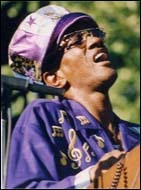 Bernie Worrell - I first met Bernie in the early 80s when he would be constantly in the studio overdubbing keyboards on numerous projects. We hit it off right away, somehow connecting in a rhythmic and melodic sense - I always knew where to punch in record and he loved it when I made it easy and it sounded good. A few notable sessions we did in Paris were visited by Mick Jagger, Charlie Watts, John-Paul Belmondo, and Miles Davis. Over the years, we've become friends, and I had the honor of having him play on 2 of my solo CD's InnerMedium and Active Resonance. Bernie is truly one of the greatest keyboard players ever. His work with Parliament/ Funkadelic, Talking heads, Pretenders etc. is legendary. He has the most pleasingly unique phrasing and melodic sense, and a wonderful touch on whatever keyboard he plays. Bernie was always a joy to work with. I will always miss his incredible playing.
Bernie Worrell - I first met Bernie in the early 80s when he would be constantly in the studio overdubbing keyboards on numerous projects. We hit it off right away, somehow connecting in a rhythmic and melodic sense - I always knew where to punch in record and he loved it when I made it easy and it sounded good. A few notable sessions we did in Paris were visited by Mick Jagger, Charlie Watts, John-Paul Belmondo, and Miles Davis. Over the years, we've become friends, and I had the honor of having him play on 2 of my solo CD's InnerMedium and Active Resonance. Bernie is truly one of the greatest keyboard players ever. His work with Parliament/ Funkadelic, Talking heads, Pretenders etc. is legendary. He has the most pleasingly unique phrasing and melodic sense, and a wonderful touch on whatever keyboard he plays. Bernie was always a joy to work with. I will always miss his incredible playing.
Check out Bernie's web site BernieWorrell.com.
Sessions
PIL Album - At the time of the recording of this record, I was still doing double sessions. So for the first part of the day I was working at RPM Studios or RCA Studios on the Tom Waits Rain Dogs record, and then at night I was working on the PIL "Album" record. The bass and drum tracks had already been recorded at the Power Station studio. Next, I got to record Steve Vai and probably some of his best guitar solos at Electric Lady Studios. We put his guitar amplifier cabinet at the top of the studio stairway, and used close mics and also several "room" mics 3 and 6 feet down the stairs - recording the stairway sound. After the guitar overdubs we moved to RPM Studios and recorded John Lydon, a.k.a. Johnny Rotton’s vocals. During the recording he would be burping, farting and spitting on the studio floor while singing. I remember spending more than a few hours, spot erasing spits, burps, and other gaseous emissions that had been recorded on tape. There were no credits on this generic release, and a lot of people don't realize that it's Ginger Baker and Tony Williams on drums, and Steve Vai on lead guitar and that Bernard Fowler sings backup vocals on almost every song.
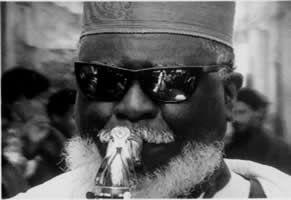 North Africa with Pharaoh Sanders - When recording in North Africa with Pharaoh Sanders we had a bit of a scare. I noticed the lights were flickering a lot in the small town of Essaouira, where we had brought all of our equipment to record. So I plugged a multi meter into an electric outlet and realized that they were only running at 95 volts! Most US outlets are 110-120 volts. After realizing there was no way to coax any more volts from their supply, I continued trying different things, including using less equipment etc.
North Africa with Pharaoh Sanders - When recording in North Africa with Pharaoh Sanders we had a bit of a scare. I noticed the lights were flickering a lot in the small town of Essaouira, where we had brought all of our equipment to record. So I plugged a multi meter into an electric outlet and realized that they were only running at 95 volts! Most US outlets are 110-120 volts. After realizing there was no way to coax any more volts from their supply, I continued trying different things, including using less equipment etc.
It turned out that the recorder that we brought there would run on 95 volts to record, but it wouldn’t playback, because there wasn't enough voltage to supply all the playback amplifiers for each channel on the tape recorder. So I could see the recordings on the meters, but we couldn't hear anything. And we didn't hear anything until we brought the tapes and gear back to the states and got the proper electricity to the gear. This was the only time I've recorded anything and was not actually able to listen back to it until much later. In the end, everything turned out fine. The tapes played back correctly when the tape machine got the correct electricity, and we mixed the record, and it was a great experience.
--------------------------------------------------------------------------------------------------------------------------------------------------
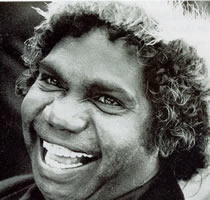 Recording in Australia -
I produced a record for Yothu Yindi an aboriginal rock band, then on Hollywood records. We did pre-production in the Blue Mountains in Australia at a wonderful horse ranch, which was great because we were able to ride every morning. While working there, I got the two aboriginal tribes that formed the band to work together on one song, and as a thank you, the tribal leaders went out and shot a wallaby and cooked it up for me, as a thank you. It was a little gamey tasting - sort of like venison. Wallabies are small versions of kangaroos.
Recording in Australia -
I produced a record for Yothu Yindi an aboriginal rock band, then on Hollywood records. We did pre-production in the Blue Mountains in Australia at a wonderful horse ranch, which was great because we were able to ride every morning. While working there, I got the two aboriginal tribes that formed the band to work together on one song, and as a thank you, the tribal leaders went out and shot a wallaby and cooked it up for me, as a thank you. It was a little gamey tasting - sort of like venison. Wallabies are small versions of kangaroos.
Also, while I was in Australia, the lead singer of the band was voted Australia's man of the year. Many festivities followed. Soon thereafter, the Australians voted in a new Prime Minister, who proceeded to ask the band to perform at the Prime Ministers inauguration ball. So right in the middle of recording the record, we all rented tuxedos and flew to Canberra for the prime ministers inauguration ball where I met Bryan Bell, Sam Neill, and Australia's new Prime Minister Paul Keating. I think it was the only American there.
back to top
--------------------------------------------------------------------------------------------------------------------------------------------------
The Transonic albums - I started creating ambient tracks around the time of the Divination albums. Several ambient artists had been invited at different times to come to Greenpoint studios to record. It was during this time that I met Peter Kuhlman, a.k.a. Pete Namlook and found out about his Germany based Fax record label featuring ambient music. Before Pete left, I gave him a copy of my first Transonic CD to check out. He really liked it and asked if he could put it out on his label. I of course said yes, and since have received very favorable reviews from those that have heard this CD. Pete once said he thought that this CD could have been the beginnings of trip hop. Because of the success of the first transonic CD, two other Transonic albums followed. All three Transonic albums are now available for download at MussoMusic.com. The three Transonic albums are: Downstream Illusion, Virtual Current and Future Primitive.
--------------------------------------------------------------------------------------------------------------------------------------------------
Ataxia - Ataxia is a collaboration of my friend Sassan Gari a.k.a. Professor Shehab and myself. Sassan had a lot of cassette recordings of different music's from the Middle East. Together we put beats together in the studio and flew in loops of his cassette tapes. We then added special effects and an ambient beat mix to form Ataxia. Many of my dancer and writer friends love this CD.
back to top
--------------------------------------------------------------------------------------------------------------------------------------------------
Transonic Re-Evolution - Transonic Re-Evolution is a CD that was originally recorded at my home studio in 2004. I was really trying to do something different and make new music with existing drum and bass drum loops. Most of the tracks on this CD use at least two different drum patterns at the same time. Usually panned hard left and hard right and then both forward and backward layered guitars are interspersed throughout to create the melodies. Check it out!
Recording
The Quality of Live Recordings - the quality of live recordings is unfortunately, sometimes not as wonderful as we would like them to be. The Machine Gun gigs especially were extremely difficult to record sometimes due to the fact that there were usually never any sound checks. Also I've always had the opinion that if I'm playing, I only concentrate on the playing side of the music and leave the recording to someone else. Most of the time that someone else, back then would have been Tom Ruff. But Tom was also doing the live sound at the gigs and usually just set up a pair of microphones plugged into an F1 digital recorder or sometimes even just a cassette machine as an afterthought, knowing that the live house sound was the priority. So, I would like to take this opportunity to apologize in advance for any poor quality recordings in this catalog. Don’t blame Tom.
--------------------------------------------------------------------------------------------------------------------------------------------------
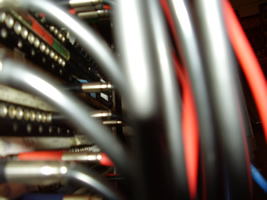 Current Studio Philosophies - I'm sometimes asked, what equipment I like to use in the studio. I'm a big fan of Neve consoles - 1073 modules, 1066 modules, 1081 and 1084 modules are my favorite Neve EQ/ preamps. I have many favorite microphones, starting with a Neumann U47, Neumann U67, Neumann U87, Km 54, KM 84, ELA M 251, C-12, Sennheiser 421, AKG 414, 451, and D-12, D-12E, microphones for kick drum and all of the ADK microphones available now. I record into a Pro Tools equipped Apple computer and use Focusrite and Apogee converters. I’m also a big fan of Neve compressors, 1176, LA2A, and Fairchild compressor/ limiters. All of the preceding compressors now have digital plug-in equivalents available in Pro tools, and I'm constantly using plug-in versions of Fairchild limiters, and Multiband compressors, Compressor Bank compressors, and any special effects I can get a hold of including the TC Electronics Fireworks, Eventide Harmonizers and all the new digital plug-ins like the Buffer Override, Scrubby and Geometer. I also like Avalon preamps and compressors and Massenburg preamps and compressors.
Current Studio Philosophies - I'm sometimes asked, what equipment I like to use in the studio. I'm a big fan of Neve consoles - 1073 modules, 1066 modules, 1081 and 1084 modules are my favorite Neve EQ/ preamps. I have many favorite microphones, starting with a Neumann U47, Neumann U67, Neumann U87, Km 54, KM 84, ELA M 251, C-12, Sennheiser 421, AKG 414, 451, and D-12, D-12E, microphones for kick drum and all of the ADK microphones available now. I record into a Pro Tools equipped Apple computer and use Focusrite and Apogee converters. I’m also a big fan of Neve compressors, 1176, LA2A, and Fairchild compressor/ limiters. All of the preceding compressors now have digital plug-in equivalents available in Pro tools, and I'm constantly using plug-in versions of Fairchild limiters, and Multiband compressors, Compressor Bank compressors, and any special effects I can get a hold of including the TC Electronics Fireworks, Eventide Harmonizers and all the new digital plug-ins like the Buffer Override, Scrubby and Geometer. I also like Avalon preamps and compressors and Massenburg preamps and compressors.
I like to mix in the old school fashion. I will have each track that's been recorded in the computer patched into an individual channel in either a Neve console or a Yamaha digital console. I sometimes mix without using automation. I do this by mixing in very small pieces. I’ll mix an intro section and then stop. And then mix the first verse and then stop and then edit the intro to the first verse. Then I will mix the first chorus and then stop and edit the first verse, together with the first chorus, etc. This continues until the whole song is mixed. This way I can really concentrate on a very small piece of music and really get a focused mix.
--------------------------------------------------------------------------------------------------------------------------------------------------
Home Recording vs. Studio Recording - I sometimes get asked if I can tell the difference between a home recording and a studio recording. Most of the times, I can. In general, I’ve found that a lot of home recordings that I receive have the standard home recording problems; Lots of background noise and hum and other unwanted sound, such as phones ringing in the distance and street noise, etc. Also, what a lot of people working at home fail to realize is that a good recording is not only the recording of the musician playing and the microphone and pre-amp, but also the sound of the room that the musician and the microphone are in. In my opinion going to a professional studio with a great sounding recording room and high technical standards is always preferable. However, nowadays, I record a lot of my guitar parts at home, at my home studio. I then transfer the finished tracks as data into the computer at a professional studio to be mixed.
back to top
--------------------------------------------------------------------------------------------------------------------------------------------------

The Professional Recording - One of the real problems I have with home recording is that anybody can buy the right gear nowadays, but without the professional experience of working in a real Pro studio - the finished product can sound more like a garage CD rather than a finished professional production. What I'm talking about is studio technique, and studio etiquette, learning how to professionally Mic up a drum kit. Organizing all of the microphone cables and headphone cables, so that people aren’t tripping over them, making sure everything gets backed up at the end of every day on two different formats. Keeping your work environment organized and clean and having accurate records of everything that has happened and where every master tape or file has been sent. Or how many copies have been made -- all of this adds up to a more professional sense of being in the studio and the difference between a sloppy home studio and a professionally run studio. I found that musicians play better or more professionally, when they feel they're in the presence of professional people who know what to expect, have done it before, and know how to treat them correctly.
This works both ways though. I've seen pristine studio environments that had been completely wrong for some rock groups. The band members really were just not used to playing in such a sterile environment, and really didn't play as well as I've heard them before. (This is where the troubleshooting and problem solving process begins).
Being professional in the studio, is only part of the story. It always starts and ends with the music. Is the band well-rehearsed? Are the songs in the right key for the singer? Is everybody in tune? What’s the tempo of the song? What instrumentation will be used? What overdubs or vocal layering will be done? What's the ultimate goal for the song/band/CD.? Do you want to be radio worthy or mixed for a club? Are you trying to create something completely new?
--------------------------------------------------------------------------------------------------------------------------------------------------
Troubleshooting and Problem Solving - troubleshooting and problem solving in the studio is an art form itself. This could mean fixing or working around technical problems. (Trying different mic cables, different patch cables, different channels on the board, different headphones, trying other guitar amps, bass amps, different microphones on the drums, which compressor to use? different reverb settings with different pre-delays, etc.) doing whatever it takes to keep the session running smoothly.
Sometimes, problem-solving has more to do with the musician’s personalities or interaction between managers, record companies, musicians and girlfriends than anything else. I usually go for a calm, logical approach. But again, whatever it takes to keep things running smoothly is usually the right thing to do.
I can't tell you how many times exercising a switch or patch cable or replacing an intermittent set of headphones has saved the session. Sometimes, it could be the smallest things that make a difference, dimming the lights or making sure someone who is reading music has enough light. Or just making someone feel comfortable can really make the difference. Whatever it takes to make it work!
--------------------------------------------------------------------------------------------------------------------------------------------------
How important it is to be a good musician or an experienced DJ to work in the studio or music making business - I've seen a lot of people, including recording school graduates, that have lots of technical and book knowledge that can be very good with computers that are not really great in the studio, because they lack basic music abilities.
Before computers got involved with music, we had 2 inch 24 track tape machines. When recording overdubs back then, a producer might say to me, "Punch track 20 into record on the upbeat of four, before the one (Or downbeat) of the second chorus". First I would have to know the difference between the verse and chorus, and then I would have to know that he was talking about - counting the beats of the measure before the second chorus. I know this sounds simple, but how many people, do you know, or don't know, how to count the beats of a measure of music? I’ve run into lots of them. What happens if the song is in 5/4 or 7/8 meter? What if the musicians are out of tune, how would you know it? Could you tune a guitar or bass if someone asked you?
Learning the basics on a musical instrument or being a really complete DJ can give you an incredible advantage in the studio.
Also, studio etiquette can be very important. I always recommend to new studio workers to, "be invisible" and please try not to get in the way. Save your questions for the end of the session. Save your comments until all musicians have left the room. Be as helpful as possible, while not forgetting the main goal is to make music, not tell stories or fool around etc. I've also seen a lot of photographers in the studio looking for the ultimate shot, and I must say I've never had a successful recording, while a photographer is clicking or flashing away. I believe time should be allotted for the photographer in the studio - outside of the recording time that will be used to make music. And yes you do hear the cameras clicking coming through the microphones.
--------------------------------------------------------------------------------------------------------------------------------------------------
 Orange Music Sound Studios – We moved our Brooklyn based Greenpoint studio to West Orange New Jersey in 2000. The Greenpoint equipment was moved into a newly created mix room over an existing studio that was originally built by one of the guys from Frankie Valli and the Four Seasons in the 1970’s. The studio had previously been called Fast-Track, and then Grand Slam studios, and I believe, Aerosmith, Jethro Tull, The Kinks, and George Benson, have all recorded there.
Orange Music Sound Studios – We moved our Brooklyn based Greenpoint studio to West Orange New Jersey in 2000. The Greenpoint equipment was moved into a newly created mix room over an existing studio that was originally built by one of the guys from Frankie Valli and the Four Seasons in the 1970’s. The studio had previously been called Fast-Track, and then Grand Slam studios, and I believe, Aerosmith, Jethro Tull, The Kinks, and George Benson, have all recorded there.
--------------------------------------------------------------------------------------------------------------------------------------------------
Greenpoint Studio - The famous Greenpoint studio, as some have called it, was one big rectangular room that had only foam dividers between the control room area, and the recording room. This made it extremely difficult to get good sounds, because you're literally in the same room as the drums and the amplifiers. The ceilings were about 10 feet high and there were no isolation booths. Another fun fact was that Greenpoint also had extremely limited heating and air-conditioning.
--------------------------------------------------------------------------------------------------------------------------------------------------
My Bands
The Beginnings of Machine Gun - on September 2, 1986, Thomas Chapin, Jair-Rohm Parker Wells, Bil Bryant and I played at the Pyramid Bar on Avenue A, as "Sounds of the Apocalypse". Soon thereafter John Richey would join us to complete Machine Gun. That first gig at the Pyramid Bar was pretty wild though. Back then, the Pyramid was a straight bar till 9 p.m. After nine it turned into a gay bar, including topless guys dancing on the bar. We started playing around 8:30 and ended around quarter to 10:00 to a completely different environment. I remember Thomas Chapin, giving me some really funny looks onstage when the changeover started to happen. Besides all the visual happenings, I think we all noticed that we sounded pretty good together and that we should probably do this again sometime.
The Complete Machine Gun - When John Richey joined us he really added the missing element, that extra dimension to our sound. John would be the word man using cut-up poetry (ala: Brion Gysin and William Burroughs) tape manipulations, and other "found Sound" that he came up with. He would contribute an equal portion of improvisation to the overall sound. He gave us that extra special element that made Machine Gun complete.
--------------------------------------------------------------------------------------------------------------------------------------------------Machine Gun - The Radio Tour - I think it was probably Steve Popkin and Peter Wetherbee that spent the most time booking and scheduling the Machine Gun Radio Tour. This was pretty unbelievable back then, because I think we played six different radio stations in a very short period of time. Each show and radio station had its own unique situation to overcome to make everything work. Most of the shows were recorded and are available for download in the improvised music section.
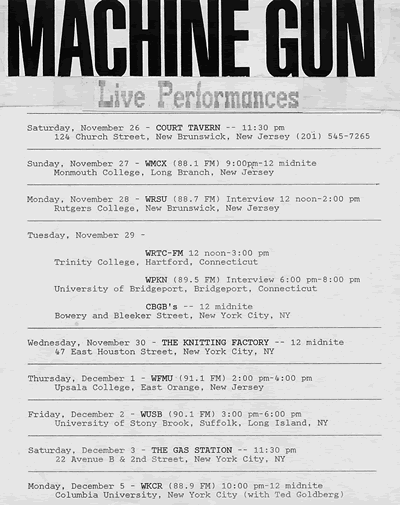
--------------------------------------------------------------------------------------------------------------------------------------------------
Machine Gun - The Guests - We have been lucky enough to have had many guests sit in with Machine Gun. They include: Sonny Sharrock, Karl Berger, Elliot Sharp, Phillip Wilson, Elliott Levin, Lance Carter, and Tom DiEllo.
--------------------------------------------------------------------------------------------------------------------------------------------------
Some Machine Gun Shows - Some Machine Gun shows were really unbelievable. At times there was so much energy and communication happening on stage that the audience would really lose it and started whopping and hollering! And then that would feed the band onstage and we would go even further, etc. I always felt bad for any band following Machine Gun on stage, especially if they weren’t playing improvised music.
--------------------------------------------------------------------------------------------------------------------------------------------------
Bil Bryant and Jair-Rohm Parker Wells - Bil and Jair-Rohm made up the incredible rhythm section for Machine Gun. They had played a lot together with different groups for quite a while before we got together. When we finally got together as Machine Gun they really complemented the whole vibe. Bil would always be listening to what I was doing and where I was going. And at the same time also be listening to Chapin, and he had the ability to play with both of us - right down the middle of our two ideas. Jair-Rohm would always be right there with him doing the same thing, fitting right into the groove. It's always a pleasure to play with these guys.
--------------------------------------------------------------------------------------------------------------------------------------------------
Bil Bryant – Bil Bryant currently runs the Stockholm, Sweden based company PowerFX, which features sound and music samples, Loops, and sound effects available for download. He can be reached at www.Powerfx.com
Bil Bryant
Borgargatan 18
11734 Stockholm, Sweden
Jair-Rohm Parker Wells - Jair-Rohm Parker Wells has lived in Stockholm, Sweden, Thailand, and New Jersey and has recently produced and released albums on MussoMusic.com,( "Motormouth Deviations", "Stand Your Ground", "Froth", "Coming Together", " Above the Convergence", "Doom Dogs", "Ad Majoram Dei Gloriam"), Red Toucan Records ("Steamroom Variations"), Klanggold ("Sympathy for the Donkey", and is presently preparing a release for Ayler Records ("Meditations on Albert Ayler). His solo CD, "Exquisite Noise" is available on CD Baby and iTunes. Jair-Rohm can be reached at: www.myspace.com/jairrohm or jairrohm@gmail.com
--------------------------------------------------------------------------------------------------------------------------------------------------
Bob's Jam Band - Bob's Jam Band came about in a rather interesting way. Several years ago, I had done a few gigs with Dave Dreiwitz and Lance Carter. After Lance passed away on November 1, 2006, Dave and I decided to get back together again and do some playing. The initial idea was to get a drummer and go into a rehearsal studio and just play. Dave mentioned a new drummer that he was doing a lot of playing with named Joe Russo. Joe was part of the jam band scene, having played with some of the members from Phish, and also having his own group the Benevetto/ Russo duo on Ropeadope records. At the same time, Raoul Bjorkenheim and I were getting together two or three times a week and doing a lot of playing together. Dave, Joe, and I tried to get together three times, but there was always a conflict of schedules. I then noticed that there was a holiday coming up, and that Orange Music Sound Studios was also not booked. I checked with Dave and Joe and also Raoul and it turned out everybody could make it. So I asked James, who usually assists me, if he could record us. The result, after some editing at my home studio is Bob's Jam Band. This was the first time that all four of us had played together. And again, there were no rehearsals and no sound checks. Joe Russo later formed JRAD – Joe Russo’s Almost Dead with Dave Dreiwitz on bass.
Everything Else
MuWorks Records – MuWorks Records was founded in 1986, mostly as an outlet for Machine Gun records, my first solo records and my friend’s albums. MuWorks artists included Last Exit, Thomas Chapin, Pheeroan akLaff, Lunar Bear Ensemble, etc. Unfortunately, MuWorks closed less than 10 years later – Mostly due to distributors going out of business. Most of the music available for download on MussoMusic.com was originally in the MuWorks catalog.
MuWorks Meetings - at these record company meetings, I would invite anybody who wanted to learn about the music business to the MuWorks office, where I would supply the beer and chips and talk about distribution or publishing or marketing etc. And then we would all work together, stuffing envelopes, stapling and labeling packages for the massive press and radio mailings that we would do. Those were the days!
The MuWorks Crew – The MuWorks Crew were: Peter Wetherbee, Bruce Gallanter, Steve Popkin, Ben Face, Cristeen Aiyb, Joe Stubby, Wes Napersak, Holly Schmidt, Lauren Alles, Ijola Fitts, John Richey, Pat Ryan, Tom Ruff, Jeremy Probber, Dave Goldin, etc.
Downtown Music Gallery - Bruce Gallanter’s Downtown Music Gallery is considered by many to be the best record store on the planet. Bruce and Manny Maris have access to more hard to get records and albums than anybody else. I met Bruce in the late 70s, and one of his annual birthday party jams. After that I used to see Bruce at all of the cool NYC gigs taping every show. I think Bruce has more early recordings of me than I do. When I started MuWorks it was great to have him help us out.
I’ve also had the pleasure and privilege of playing with or on albums with:
Alan Ginsberg, Jackson Krall, Mark Hennen, Elliott Levin, John Blum, Ornette Coleman, William Hooker, Byard Lancaster, Dave Liebman, Bernie Worrell, Bootsy Collins, Jonas Hellborg, Bil Bryant, Jair-Rohm Parker wells, John Richey, Thomas Chapin, Mark Daterman, Melanie Silvernail, P.M. Dawn, Ginger Baker, Joe Russo, Dave Dreiwitz, Raoul Bjorkenheim, Lex Gray, Henry Kaiser, Glen Moore, Sonny Sharrock, Karl Berger, Lance Carter, Weasel Walter, Nick Didkovsky, Jessie Krakow, Calvin Weston, Steve Buchanan, Bill Laswell, Aiyb Dieng, Charles Burnham, Richard Graham, Bob Ostertag, Shanir Blumenkranz, etc.
I’ve studied guitar with: Tal Farlow, Ted Dunbar, and John Scofield
